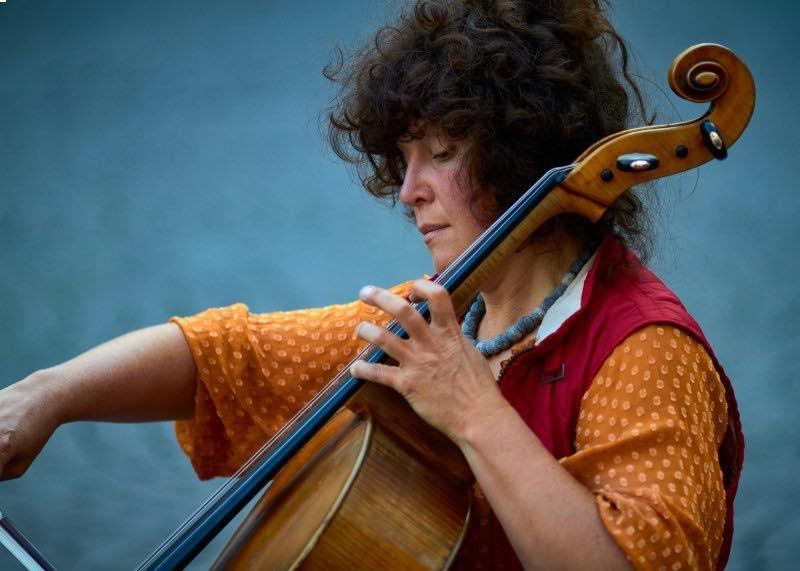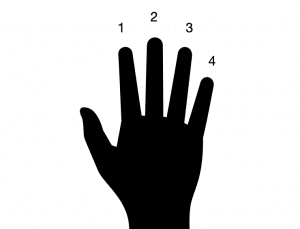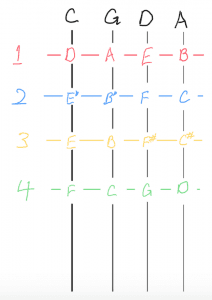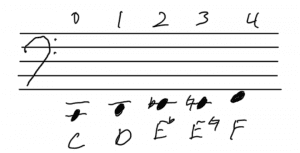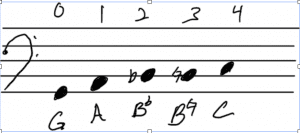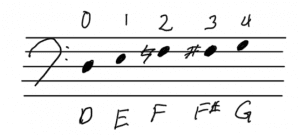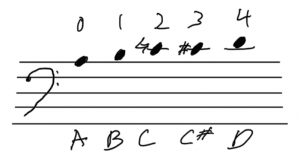Congratulations! You have started learning the ways of the cello, welcome young padawan. Let’s talk about how to make sounds other than our open strings, look at a basic cello fingering chart, and talk about positions. On cello we will eventually use all five fingers of the left hand to reach to the farthest extents of our physical abilities, but for now, let’s focus on just four.
On cello, we number our fingers from 1 to 4 starting on our index finger, like so:
The placement of our hand in relationship to the fingerboard is its position. There are a lot of positions, but for now we will only be discussing where our fingers will be in first, what I call stretch, and half position.
An important thing to note:
If you do not have tapes, your first finger is a little less than two inches from the nut.
Here is a basic cello fingering chart that shows all of the notes in first position on all of the strings:
Something important to note is that between each finger is a half step, which means that each finger/note is incremental or chromatic. On the C string, the lowest string, this is where all the notes from the diagram above are on the staff:
Notes on the G String in the staff:
Notes on the D String in the staff:
Notes on the A String in the staff:
Those are all of the notes in first position without contouring your hand, and stretching in any kind of way.
I implore you, LEARN this so well that you could be woken up at 3am, out of a dead sleep, and play these notes. My second teacher would say that to me all the time. I cannot stress how important knowing these diagrams is to your future understanding of the cello.
Tricks Memorize These Cello Fingering Charts
To study these diagrams, you can put the note name on one side of a flashcard and the note and finger/string on the other. Go through these flashcards at least two times a day for a week and by the end of a week, you’ll know the notes and where they are on the cello like the back of your hand!
I did say that we would learn two other positions; one is still similar to first, the other is half position. The previous set is standard first position. I like to think of positions as being flexible, but they do have limits. For now, let’s leave it at that because the discussion of playing in positions is a slippery slope!
One of my students has downs syndrome, and we often talk about playing in a STRETCH position. For him that means that instead of using all four fingers, to play in our typical three half step setup, we will have two whole steps. Diagrams for this are not provided because this is the next step in our musical and cello evolution. It is important to know, but you need to spend LOTS of time learning and memorizing these concepts before moving on to stretch positions.
To those of you that feel confident and believe that you know all of your notes in first position — QUICK! What is note is your third finger on the G string!
If you answered B, congratulations! You are ready to move on!
Playing Stretch Positions
In stretch position, our fingers are in whole steps.
If you think of the relationship between our fingers normally in first position, this means that our fingers are going to be stretched quite a bit more than normal to play certain notes. Let’s use the G string as an example.
Instead of our typical first position setup that we had above, we will only use three fingers: first, second, and fourth. The reason behind this is likely because our ring finger is anatomically weaker than the other fingers.
We know that on G, our first finger goes on A, third on B, and fourth on C. In stretch position, our first finger will still be on A, but instead of our third finger on B it will be our second finger.
Take a second, think about that…okay, feel alright? Now, your fourth finger is on C# (a half step above C [4] on G). To review, 1 on A, 3 on B, and 4 on C#, all on the G string.
Playing Half Positions on the Cello
Let’s discuss the concept of a half position. Half position is our normal first position, just down a half step. If we use A as an example, this means that we will have our first finger on Bb, 2 on B, 3 on C, and 4 on C#.
These concepts are all very important to the foundation of cello playing. Please learn first position as shown in the cello fingering chart above first. When you feel like you can get around perfectly in first position and your repertoire allows it, play around with the extended and half position.
Happy practicing!
Braxton Alexander Porter
